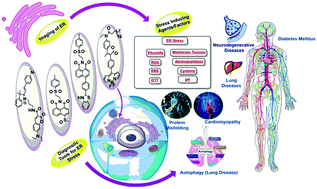Fluorescent probes for targeting endoplasmic reticulum: design strategies and their applications
Abstract
Advances in developing organic fluorescent probes and fluorescence imaging techniques have enhanced our understanding of cell biology. The endoplasmic reticulum (ER) is a dynamic structure that plays a crucial role in protein synthesis, post-translational modifications, and lipid metabolism. The malfunction of ER contributes to several physiological and pathological conditions. Therefore, the investigations on the imaging and role of ER have attracted a lot of attention. Due to their simplicity, synthetic tunability, photostability, high quantum yields, easier cellular uptake, and lower cytotoxicity, organic fluorophores offer invaluable tools for the precision targeting of various cellular organelles and probe ER dynamics. The precision staining is made possible by incorporating specific functional groups having preferential and local organelle biomolecular interactions. For instance, functional moieties such as methyl sulfonamide, sulfonylurea, and pentafluorophenyl assist in ER targeting and thus have become essential tools to probe a deeper understanding of their dynamics. Furthermore, dual-function fluorescent probes that simultaneously image ER and detect specific physiological parameters or biological analytes were achieved by introducing special recognition or chemically reactive sites. This article attempts to comprehensively capture various design strategies currently employed by researchers utilizing small organic molecules to target the ER and detect specific analytes.

- This article is part of the themed collection: Multimolecular Crowding in Biosystems


 Please wait while we load your content...
Please wait while we load your content...